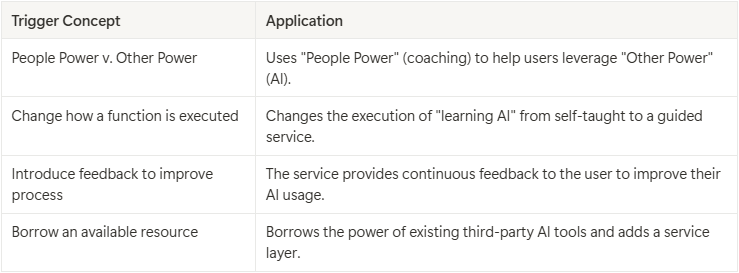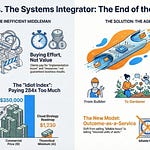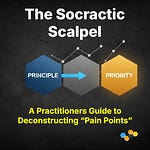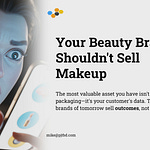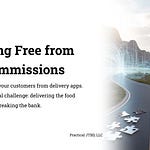Introduction: The Siren Song of the "Better" Product
Let me tell you a story you’ve probably heard before. It’s about a founder—let’s call her Sarah. Sarah is brilliant. She and her team spent two years and every dollar of their seed funding building a project management tool. It was beautiful. It was faster, had more features, and integrated with more apps than any competitor on the market. It was, by every conceivable metric, a better product.
They launched. The initial tech press was positive. A few early adopters signed up. And then… crickets. Engagement stalled. Churn was high. The features they’d spent months perfecting went unused. The team was baffled. They had out-maneuvered the competition on every front, but the market didn't seem to care. Within a year, the company was dead.
This isn't just a sad story; it's a startup tragedy that plays out every single day. And it’s almost always caused by the same, single, devastating mistake.
It’s a mistake I call "Product Gravitation."
Product Gravitation is the natural, powerful, and deeply flawed tendency for founders and companies to define their entire universe by their product. It’s the overwhelming force that pulls all your thinking, all your strategy, and all your resources into an orbit around a single question: "How can we build a better product?" This leads you to obsess over features, benchmark against competitors, and pour resources into incremental performance gains.
On the surface, it feels right. It feels productive. But it’s the single most common and costly mistake in innovation. It traps you in a "war of features" that you can't win, fighting for inches while your competitors are claiming miles. It leads to incrementalism at best and, at worst, building a beautiful solution to a problem nobody has.
But what if there was a way to break free from this gravitational pull? What if you could fundamentally shift your perspective and see a vast, unexplored universe of opportunity that your competitors are completely blind to?
There is. This article will give you a framework to escape the trap. We’re going to deconstruct the "better product" fallacy using First Principles Thinking. Then, we'll give you a new map and a new compass: a unified framework that combines the deep customer understanding of Jobs-to-be-Done (JTBD) with the expansive landscape of Doblin's 10 Types of Innovation.
You'll learn that the goal isn't to build a better product. The goal is to help your customer get a job done. And once you see that, you'll realize you can innovate in places you never even knew existed.
Deconstructing the Mistake with First Principles Thinking
To escape the trap of Product Gravitation, we first need to understand why it’s a trap to begin with. We can’t just accept it; we need to break it down to its core. The most powerful tool for this kind of deconstruction is First Principles Thinking. It’s a method of reasoning that challenges you to question every assumption until you are left with only fundamental, undeniable truths.
Let’s apply it to the mistake.
Step 1: Identify the Common Assumption
The central assumption that fuels Product Gravitation is this: "To win, we must build a better product than the competition."
This single idea dictates the strategy of most companies. It defines their R&D, their marketing, and their metrics for success. But is it a fundamental truth?
Step 2: Break It Down to Its Fundamental Principles
Now, we challenge that assumption by asking "why" until we can't anymore.
Assumption: Customers are looking for, and buy, products.
First Principle: This is false. Customers don't want a quarter-inch drill; they want a quarter-inch hole. They have a goal they are trying to achieve, a task to complete, a problem to solve. In other words, they have a Job-to-be-Done. They don't buy products; they "hire" solutions to help them make progress in their lives. The product is just a temporary, transient means to an end. The job is what's stable.
Assumption: "Better" means more features, higher performance, or superior technology.
First Principle: "Better" is defined by the customer, not the engineer. It means helping them get their job done more effectively. This could mean faster, more predictably, or with a better outcome. But often, it means with less effort, less complexity, or less cost. Sometimes, the "better" solution has dramatically fewer features. Compare listening to music on Spotify to a hi-fi system from the 1980s. The hi-fi has more visible "features" (knobs, dials, components), but Spotify gets the job of "accessing and enjoying music" done infinitely better.
Assumption: The market is defined by the product category (e.g., the "project management software market").
First Principle: A market is not a product category; a market is a group of people trying to get a job done. This redefinition is critical. Product categories are fleeting—they evolve and die as technology changes. The "encyclopedia market" is gone. But the job of "quickly accessing reliable information" is bigger than ever. When you define your market by the job, you have a stable, long-term focal point for creating value, regardless of how technology changes.
Step 3: Reconstruct from the Ground Up
Once we’ve stripped away the faulty assumptions, we can build a new, more powerful foundation for our strategy.
The new foundation is not the product. The new foundation is the Job-to-be-Done.
This is the fundamental truth. Your customer has a job. Your purpose is to help them get that job done better. This is the only reason your company should exist. When you start here, from this first principle, the entire landscape of innovation changes. You’re no longer tethered to the features of your product; you’re liberated to find the best possible way to solve the customer’s real problem.
The Escape Plan: A Unified Framework for True Innovation
Reasoning from first principles gets us to the core problem: the Job-to-be-Done. But how do we translate that insight into a concrete innovation strategy? We need a map that shows us all the possible places we can innovate.
This is where we combine the why with the where.
The WHY (The Compass): Jobs-to-be-Done (JTBD) provides the direction. It’s the rigorous process of identifying, defining, and prioritizing the customer’s job and their unmet needs (or "desired outcomes"). It tells you why a customer acts and what they value, giving you a precise target for innovation.
The WHERE (The Map): Doblin's 10 Types of Innovation provides the landscape. It’s a framework that shows there are ten distinct and powerful ways to innovate. Most companies compete on just one: Product Performance. But the most successful companies innovate across multiple types, creating a complex, hard-to-copy system of advantages.
When you put these two together, you get a unified framework for escaping Product Gravitation. JTBD gives you the specific, high-value problems to solve, and the 10 Types framework gives you a full palette of potential solutions, forcing you to think far beyond the product itself.
[Image: A diagram showing the JTBD process funneling "unmet needs" into the center of the Doblin's 10 Types of Innovation wheel, which then radiates outward with different innovation ideas.]
The Innovation Landscape: Finding Opportunities Beyond the Product (The Deep Dive)
This is where we put the framework into practice. We're going to take a tour of all ten types of innovation. For each one, we'll see how a deep understanding of the customer's Job-to-be-Done unlocks unique and powerful opportunities that are invisible if you’re only thinking about your product.
The ten types are organized into three categories: Configuration, Offering, and Experience.
Configuration: The Engine Room of Your Business
These innovations are focused on your internal operations and business system. They are often invisible to the end customer but can be the source of your most powerful and defensible advantages.
1. Profit Model Innovation
What It Is: This is about how you make money. It’s not just about changing your price; it’s about fundamentally rethinking how you capture value.
The JTBD Connection: When you understand the customer's entire job, you uncover all the costs and frustrations associated with it. Customers don't just pay for your product; they pay with time, effort, and by purchasing related services. JTBD reveals what customers truly value and are willing to pay for. If they struggle with high upfront costs but need an ongoing capability, a subscription model might get the job done better. If they value outcomes, not ownership, a pay-per-use model might be superior.
Real-World Example: Netflix. Blockbuster's profit model was based on per-rental transactions and punitive late fees. This was completely misaligned with the customer's job of "being entertained at home conveniently and without stress." Netflix understood this. Their subscription model eliminated late fees (a major pain point) and aligned their success with the customer's ability to consume content, not transact for it.
Future Concept: The "Capability as a Service" Model for Home Maintenance.
The Job: "Maintaining a safe and functional home."
Today's Mess: Homeowners hire a dozen different contractors (plumbers, electricians, HVAC techs), pay for each transaction separately, and struggle to manage the scheduling and quality control.
The Novel Solution: A single subscription service that guarantees the outcome of a functional home. For a flat monthly fee, the service proactively monitors systems (using IoT sensors), performs preventative maintenance, and handles all repairs with a dedicated crew. The homeowner is no longer hiring a "plumber"; they are hiring "a home that just works." This shifts the profit model from transactions to a guaranteed outcome.
Creativity Triggers
2. Network Innovation
What It Is: This is about creating value by connecting with others. It’s about leveraging the strengths, technologies, and customer bases of partners to create an offering that you couldn't build alone.
The JTBD Connection: No single company can get the entire, complex job done for a customer. JTBD helps you map the whole job and see which parts you are best at and where there are gaps. These gaps are opportunities for network innovation. Who else serves your customer while they are trying to get their job done? How can you partner with them to create a seamless experience?
Real-World Example: Apple's App Store. Apple knew the job of a smartphone user wasn't just "make calls." It was "be productive, entertained, and connected on the go." They couldn't build every solution for that job. So, they created a network. They provided the platform (iOS) and the channel (App Store) and enabled a global network of developers to create solutions for millions of specific micro-jobs, capturing value from every transaction.
Future Concept: The "Personalized Health Operating System."
The Job: "Proactively managing my long-term health and wellness."
Today's Mess: A fragmented system. Your doctor has your medical records, your gym has your workout data, your grocery app has your nutrition data, and your meditation app has your stress data. Nothing talks to each other.
The Novel Solution: An open platform that doesn't try to be the best at everything. Instead, it creates a network of best-in-class apps and services (for fitness, nutrition, mental health, diagnostics) that all plug into a central "health OS." The platform's job is to integrate the data, provide personalized insights, and coordinate actions between the different network partners. You get a holistic view and proactive recommendations, and each partner gets access to a wider user base.
Creativity Triggers
3. Structure Innovation
What It Is: This is about how you organize your company's talent and assets. It can be anything from your team structure to how you manage your supply chain. The goal is to align your structure to create unique value.
The JTBD Connection: A traditional, siloed organizational structure (sales, marketing, engineering) is built around the company's functions, not the customer's job. When you understand the job, you can structure your organization to mirror it. You can create cross-functional "job teams" dedicated to improving specific steps of the customer's job, ensuring that everyone is focused on the same customer-centric goal.
Real-World Example: Whole Foods Market. Most grocery stores are structured around optimizing supply chains for packaged goods. Whole Foods structured itself differently. They empowered local managers to source products from local farmers and artisans. This decentralized structure was more complex, but it was perfectly aligned to help customers get the job of "sourcing fresh, healthy, and unique food" done, something a centralized, efficiency-focused structure couldn't do.
Future Concept: The "On-Demand Talent Cloud" for Creative Projects.
The Job: "Assembling a world-class team to execute a specific, complex creative project (like a film or a major marketing campaign)."
Today's Mess: Hiring is slow, expensive, and relies on fixed roles. You hire a "full-time video editor" even if you only need their specific skills for 3 months.
The Novel Solution: A company that is structured not as a collection of employees, but as a "talent operating system." They maintain a deeply vetted, credentialed network of freelancers. When a client comes with a project, the company's core team acts as producers, using AI to instantly assemble a bespoke "dream team" from the network, perfectly matched to the project's needs. The structure is fluid, assembling and disassembling teams on demand. This gets the job done faster, with higher quality talent, and at a lower cost than a traditional agency model.
Creativity Triggers
4. Process Innovation
What It Is: This refers to your signature or superior methods for doing your work. It’s about developing a unique capability in how you produce, deliver, or service your offering that allows you to outperform competitors.
The JTBD Connection: When you map the customer's job, you identify all the steps and outcomes they care about. This allows you to redesign your internal processes to directly optimize for those outcomes. If customers struggle with long wait times, you can innovate your production process for speed. If they value consistency, you can innovate for quality control.
Real-World Example: Toyota Production System (TPS). The job of a car manufacturer is to "produce reliable vehicles efficiently." Toyota developed a revolutionary process focused on "just-in-time" manufacturing and "continuous improvement" (kaizen). This process innovation dramatically reduced waste, improved quality, and allowed them to respond to market changes faster than competitors. Their competitive advantage wasn't just their cars; it was the process they used to build them.
Future Concept: "Generative Manufacturing" for Custom Products.
The Job: "Acquiring a physical product that is perfectly tailored to my specific needs and body."
Today's Mess: Mass production. We buy shoes in standard sizes, furniture in standard dimensions. Customization is slow and extremely expensive.
The Novel Solution: A company that masters the process of generative design and 3D printing at scale. A customer scans their foot with their phone. A generative AI designs a shoe perfectly contoured to their foot, optimized for their gait. The design is sent to a local micro-factory and 3D printed on demand. The core innovation isn't the shoe itself; it's the end-to-end, data-driven process that can create a unique, bespoke product for the cost of a mass-produced one.
Creativity Triggers
Offering: What You Sell
These are the innovations most people think of first. They relate directly to your core products and services.
5. Product Performance Innovation
What It Is: This is the classic type of innovation: improving the features, functionality, and quality of your core offering.
The JTBD Connection: This is where most companies live, but they often do it blindly, adding features for the sake of features. JTBD provides the crucial focusing lens. Instead of just making the product "better" in a generic sense, you can focus on improving its performance on the specific outcomes that are most important and underserved for the customer. It helps you answer: "Of the 100 things we could improve, which 5 will actually help the customer get the job done significantly better?"
Real-World Example: Dyson Vacuums. The job is "clean the home." Competitors were focused on adding more attachments or making vacuums quieter. James Dyson identified a key underserved outcome: "minimize the loss of suction as the bag fills up." He developed a completely new cyclonic system to address this single, critical pain point. The superior performance on this one outcome allowed Dyson to dominate the premium market.
Future Concept: The "Cognitive Earbud."
The Job: "Effortlessly focus on desired sounds while eliminating distractions."
Today's Mess: Noise-canceling headphones are a blunt instrument. They block everything, including sounds you might want to hear (like a colleague saying your name or a car horn).
The Novel Solution: An earbud that doesn't just cancel noise, but actively curates your soundscape. Using AI and advanced microphones, it learns what sounds are important to you in different contexts. It can isolate and enhance a single voice in a loud cafe, let an emergency siren through while blocking traffic noise, and translate a foreign language in real-time, all while feeling completely transparent. The performance innovation is in the selective and intelligent modulation of sound, not just its removal.
Creativity Triggers
6. Product System Innovation
What It Is: This is about creating a system of complementary products and services that work together. The goal is to create additional value by making your core offering part of a larger, integrated ecosystem.
The JTBD Connection: The customer's job is rarely solved by a single product. It's a process that often involves multiple tools and services. By mapping the entire job, you can identify opportunities to create complementary offerings that help with other steps in the process. This not only creates more value for the customer but also builds a powerful moat; competitors might copy your product, but it's much harder to copy your entire system.
Real-World Example: Microsoft Office. The job wasn't just "write a document" or "create a spreadsheet." The higher-level job was "be productive in an office environment." Microsoft created a system of products (Word, Excel, PowerPoint, Outlook) that were designed to work together seamlessly. You could embed a spreadsheet in a document or email a presentation. The value of the system was far greater than the sum of its parts.
Future Concept: The "Modular Home Ecosystem."
The Job: "Adapting my physical living space to my changing life needs (new baby, remote work, aging parents)."
Today's Mess: Houses are static. Changing them requires expensive, disruptive renovations.
The Novel Solution: A company that sells a core "hub" house but also a product system of modular, intelligent "room pods." Need a home office? Order the "Office Pod," and it's delivered and seamlessly integrated into your home's structure and utilities. Need a nursery? Swap the office pod for a "Nursery Pod." The system includes the physical pods, the software to manage them, and a service to handle the logistics. The innovation is selling a dynamic, adaptable living system, not just a static house.
Creativity Trigger Reference
Experience: How You Sell It
These innovations are focused on your customer-facing elements. They are about how you design and deliver the more intangible aspects of your offering.
7. Service Innovation
What It Is: This is about enhancing the value of your offering through support and enhancements. It’s about making your product easier to use, more valuable over time, and ensuring customers get the most out of it.
The JTBD Connection: The customer's job doesn't end when they buy your product. They have to learn how to use it, maintain it, integrate it, and dispose of it. These are all "consumption chain jobs." JTBD helps you identify where customers struggle in this lifecycle and design services to help them. Great service innovation can turn a confusing product into a delightful experience.
Real-World Example: Geek Squad. The job isn't just "buy a computer." It's "using technology effectively without frustration." Best Buy recognized that customers struggled immensely with setup, troubleshooting, and repairs. They created Geek Squad, a service innovation that wrapped their core product offering with the support needed to get the whole job done. For many, the value of the service was higher than the value of the product itself.
Future Concept: "Personal AI Training & Integration Service."
The Job: "Leveraging the power of AI to improve my personal and professional productivity."
Today's Mess: There are hundreds of powerful AI tools, but they are complex, disconnected, and require significant effort to learn and integrate into a personal workflow.
The Novel Solution: A subscription service that acts as a personal "AI trainer." It doesn't sell the AI tools themselves. It helps you choose the right ones for your job, designs a custom, integrated workflow for you, and provides ongoing training and support to ensure you're getting the maximum value. The service could include personalized prompts, automation templates, and one-on-one coaching. It's a pure service innovation that makes the underlying (and often free) products infinitely more valuable.
Creativity Trigger Reference:
8. Channel Innovation
What It Is: This is about how you deliver your offering to your customers. It’s about making it easier, more convenient, or more delightful for them to find, buy, and receive your product or service.
The JTBD Connection: The customer's context is critical. Where and when are they trying to get the job done? Understanding this helps you design channels that meet them where they are. If the job is urgent and happens on a job site, a physical retail channel might be a terrible choice, while an on-demand delivery service could be a breakthrough.
Real-World Example: Nespresso. The job is "make a high-quality cup of espresso at home without the mess and complexity of a traditional machine." How did they deliver this? They bypassed traditional retail channels entirely. They created a direct-to-consumer channel through their "Nespresso Club" and elegant boutiques. This allowed them to control the customer experience, create a sense of premium exclusivity, and build a direct relationship for recurring pod sales. The channel was as innovative as the product.
Future Concept: "Immersive Commerce" for Complex Products.
The Job: "Confidently purchasing a complex, configurable product (like a car or a modular sofa) that will fit my space and my life."
Today's Mess: We look at 2D pictures online or visit a showroom with limited options. It's hard to visualize the product in our own space, leading to a lack of confidence and high return rates.
The Novel Solution: A channel that is a photorealistic, persistent Augmented Reality (AR) app. You don't just "view" the car; you place a full-scale, interactive model in your own driveway. You can walk around it, get inside, change the colors, and see how it looks at night. You configure and purchase it directly within the AR experience. The channel isn't just a way to transact; it's a tool that helps the customer get the "evaluating and choosing" part of the job done with perfect confidence.
Creativity Trigger Reference:
9. Brand Innovation
What It Is: This is about how you represent your business and your offerings. A strong brand is a promise. It communicates a set of values and expectations that help customers choose you.
The JTBD Connection: JTBD reveals that customers have functional, emotional, and social dimensions to their jobs. They don't just want to do something; they want to feel a certain way and be perceived a certain way. Brand innovation is about aligning your promise with these deeper emotional and social jobs.
Real-World Example: Patagonia. The functional job is "stay warm and dry outdoors." But Patagonia recognized the deeper social and emotional job of their customers: "live an adventurous life and be a responsible steward of the environment." Their brand is built entirely around this job. Their "Don't Buy This Jacket" campaign, their environmental activism, and their product quality all work together to make a powerful promise. Customers don't just buy a jacket; they buy an identity.
Future Concept: The "Transparent Provenance" Brand.
The Job: "Consuming products that align with my personal values of sustainability and ethical production."
Today's Mess: Brands make vague claims ("sustainably sourced") with little proof. It's hard for customers to trust them.
The Novel Solution: A brand built entirely on the promise of radical transparency, enabled by blockchain. Every component of a product—from the cotton in a t-shirt to the coffee bean in a bag—is tracked on a public ledger from source to sale. The customer can scan a QR code and see the entire journey: the farm it came from, the wages of the worker who picked it, the carbon footprint of its transport. The brand isn't an abstract story; it's a verifiable, immutable record of its own promise. This gets the "trust and verification" job done perfectly.
Creativity Trigger Reference:
10. Customer Engagement Innovation
What It Is: This is about fostering compelling, meaningful interactions with your customers. It’s about moving beyond a transactional relationship to build a real connection.
The JTBD Connection: The customer's job is a process that unfolds over time. Customer engagement innovation is about finding ways to add value and support them throughout that process. How can you help them learn, monitor their progress, connect with others doing the same job, and feel a sense of mastery?
Real-World Example: Nike+ (now Nike Run Club). The job isn't "buy running shoes." The job is "stay motivated to be a consistent runner." Nike created an app and a community that engaged customers long after the sale. It allowed them to track their runs, set goals, challenge friends, and receive encouragement. This engagement transformed Nike from a shoe company into a running partner, building immense loyalty.
Future Concept: The "Dynamic Learning Companion."
The Job: "Mastering a new, complex skill (like learning to code, play a musical instrument, or speak a new language)."
Today's Mess: Learning is often a lonely, frustrating process. We watch pre-recorded videos or follow a static curriculum. We get stuck and lose motivation.
The Novel Solution: An AI-powered engagement platform that acts as a personal tutor, coach, and accountability partner. It doesn't just provide content; it engages with you dynamically. It analyzes your code and suggests improvements in real-time. It listens to you play the piano and highlights wrong notes. It creates personalized practice sessions based on your weak spots and sends you encouragement when it detects you haven't practiced in a few days. The engagement is the product, creating a continuous, adaptive conversation that keeps the learner on track.
Creativity Trigger Reference:
A Glimpse of the Future: How Tomorrow's Solutions Get the Job Done
When you look at the novel concepts we've explored, a pattern emerges. The future of innovation isn't about isolated products getting incrementally better. It's about a fundamental shift in how value is created.
Future solutions will be higher-context. They will understand the customer's broader goal, not just the immediate task. The "Cognitive Earbud" doesn't just block noise; it understands your goal of "focusing" and actively helps you achieve it.
They will be integrated and systemic. Today's solutions are often fragmented. We use a dozen apps and services to manage our health or our home. The "Personalized Health OS" and the "Modular Home Ecosystem" show a future where integrated systems get the entire job done on a single, coherent platform. They will have fewer visible features for the user because the complexity is handled by the system, not the person.
And most profoundly, they may change the job performer entirely. The "Generative Manufacturing" process shifts work from human hands to an automated system. The "On-Demand Talent Cloud" changes the performer from a full-time employee to a fluid, on-demand specialist. This is the ultimate form of getting the job done better—by abstracting away the difficult parts of the job itself.
Escaping Product Gravitation doesn't just lead to better products. It leads to entirely new business models, new experiences, and new ways of creating value that are impossible to imagine when you're stuck staring at your own solution.
Your Action Plan: How to Avoid Product Gravitation
This all might seem theoretical, but you can start applying this thinking today. Here is a practical, step-by-step guide to reorient your innovation strategy around the Job-to-be-Done.
Pause and Ask Why. Before you write another line of code or design another feature, stop. Go talk to your customers (and people who aren't your customers). But don't ask them about your product. Ask them about their life. Ask them about what they are trying to accomplish. Ask them about their struggles. Your goal is to understand their job, not their opinion of your solution.
Define the Job, Not the Market. Work with your team to write a clear "job statement." What is the customer really trying to do? What is the progress they are trying to make? Remember to include the functional, emotional, and social dimensions. Frame this as your market.
Map the Job, Not the Journey. Break the customer's job down into its core functional steps (a great starting point is the universal job map: define, locate, prepare, confirm, execute, monitor, modify, conclude). For each step, identify the customer's desired outcomes. Where are they struggling? Where is there friction?
Quantify the Opportunity. Don't guess what's important. Survey your market. For each desired outcome you identified, find out how important it is to them and how satisfied they are with their current solutions. This will give you a data-driven "opportunity landscape," showing you exactly where the most urgent, unmet needs are.
Scan All 10 Types. Take your top opportunities—your most important and underserved outcomes—and brainstorm solutions across the entire Doblin framework. Don't just jump to Product Performance. How could you solve this with a new Profit Model? A new Service? A new Channel? This will force you out of your default thinking.
Build a Defensible Portfolio. The strongest companies don't rely on a single innovation. They build a system. Combine innovations from multiple types to create a holistic solution that is incredibly difficult for competitors to copy. A great product is a good start. A great product combined with a unique service and a novel profit model is a fortress.
Conclusion: A Shift in Perspective
The story of Sarah and her "better" product is a cautionary tale about the immense gravitational pull of the product. It’s a force that feels natural and logical, but it keeps you trapped in a small, crowded, and dangerous space.
Escaping that pull requires a conscious and profound shift in perspective. It’s a shift from being product-centric to being customer-centric is not enough. It is a shift to being job-centric. It’s the realization that customers don't care about you or your product; they care about their own progress. They have a job to do, and they will hire the solution that helps them do it best.
This is more than just a new methodology; it’s a new mindset. It changes the questions you ask, the opportunities you see, and the way you measure success. When you stop asking, "What can I build?" and start asking, "What job can I help the customer do better?"—you don't just build better products. You build things that matter.
What's a real-world example you've seen of a company that failed because it was too focused on its product? Or, on the flip side, a company that succeeded by innovating in a non-obvious way (beyond just its product features)?
Share your story in the comments below. I’d love to hear your examples.
Follow me on 𝕏: https://x.com/mikeboysen
If you'd like to see how I apply a higher level of abstraction to the front-end of innovation, please reach out. My availability is limited.
Mike Boysen - www.pjtbd.com
Why fail fast when you can succeed the first time?
My Blog: https://jtbd.one
📆 Book an appointment: https://pjtbd.com/book-mike
Join our community: https://pjtbd.com/join









